Vincent van Gogh’s ‘Sunflowers’ (1888) captures vibrant blooms in vivid color, showcasing his unique brushwork and emotional depth in this iconic masterpiece
Here’s a detailed overview of Vincent van Gogh’s Sunflowers (1888) with specific insights into its creation, technique, and significance:
Artist: Vincent van Gogh
Year of Creation: 1888
Technique: Oil on canvas
Art Movement: Post-Impressionism
Time of Creation: Van Gogh painted Sunflowers during the summer of 1888, while he was living in Arles, in the south of France. The series of sunflower paintings was created as part of his preparation to welcome the artist Paul Gauguin, who was coming to stay with him.
Composition: The Sunflowers series primarily depicts a vase filled with sunflowers at different stages of life, from full bloom to wilting. The flowers are arranged in a relatively simple, yet dynamic composition, with a focus on the vibrancy and movement of the blooms. The background is often a contrasting color that makes the sunflowers stand out, enhancing their impact.
Colors: Van Gogh used a warm, radiant color palette dominated by yellows, oranges, and greens. The vibrant yellows are particularly notable, as Van Gogh used several shades to bring out the texture and the lifelike quality of the petals. The complementary use of blue or turquoise in the background serves to highlight the intensity of the yellow flowers.
Influences: Van Gogh was influenced by the bright colors and bold forms of Japanese prints, which he greatly admired. The simplicity and clarity of these prints resonated with him and influenced his own use of color and composition. Additionally, Van Gogh’s study of the natural world and his admiration for the beauty found in simple, everyday objects deeply informed his approach to Sunflowers.
Context in Van Gogh’s Career: Sunflowers is one of Van Gogh’s most iconic series and reflects his transition into a more mature style characterized by bold color, expressive brushwork, and a deep emotional connection to his subject matter. This series also represents Van Gogh’s hope for artistic collaboration and community, as it was intended to decorate the room where Gauguin would stay in the “Yellow House” in Arles.
Symbolism and Themes: The sunflowers symbolize gratitude and friendship, which Van Gogh wanted to express through his paintings in anticipation of Gauguin’s visit. The cycle of life is also a prominent theme in the series, with the flowers depicted in various stages from full bloom to decay, perhaps reflecting Van Gogh’s awareness of the fleeting nature of life.
Critical Reception: Initially, Van Gogh’s Sunflowers series did not receive widespread acclaim. However, over time, they have come to be recognized as masterpieces of Post-Impressionism, celebrated for their bold use of color and emotional depth. Today, they are among the most beloved and frequently reproduced works of art in the world.
Location: The original Sunflowers paintings are housed in various museums around the world, including the Van Gogh Museum in Amsterdam, the National Gallery in London, and the Neue Pinakothek in Munich. Each version has its unique color variations and composition.
Preparatory Works: Van Gogh created multiple versions of Sunflowers, experimenting with different arrangements and color schemes. These studies and variations show his evolving approach to capturing the essence of the flowers and his dedication to refining his technique.
Influence on Later Works: The bold color and simplified forms seen in Sunflowers would go on to influence Van Gogh’s later works. The series marks a pivotal point in his exploration of expressive color, which became a hallmark of his style and had a profound impact on modern art.
This overview gives a comprehensive understanding of Van Gogh’s Sunflowers, highlighting its significance within his body of work and its lasting influence on the art world. Visit the Van Gogh Exhibition to see the iconic ‘Sunflowers’ and other masterpieces that showcase Van Gogh’s vibrant artistry.
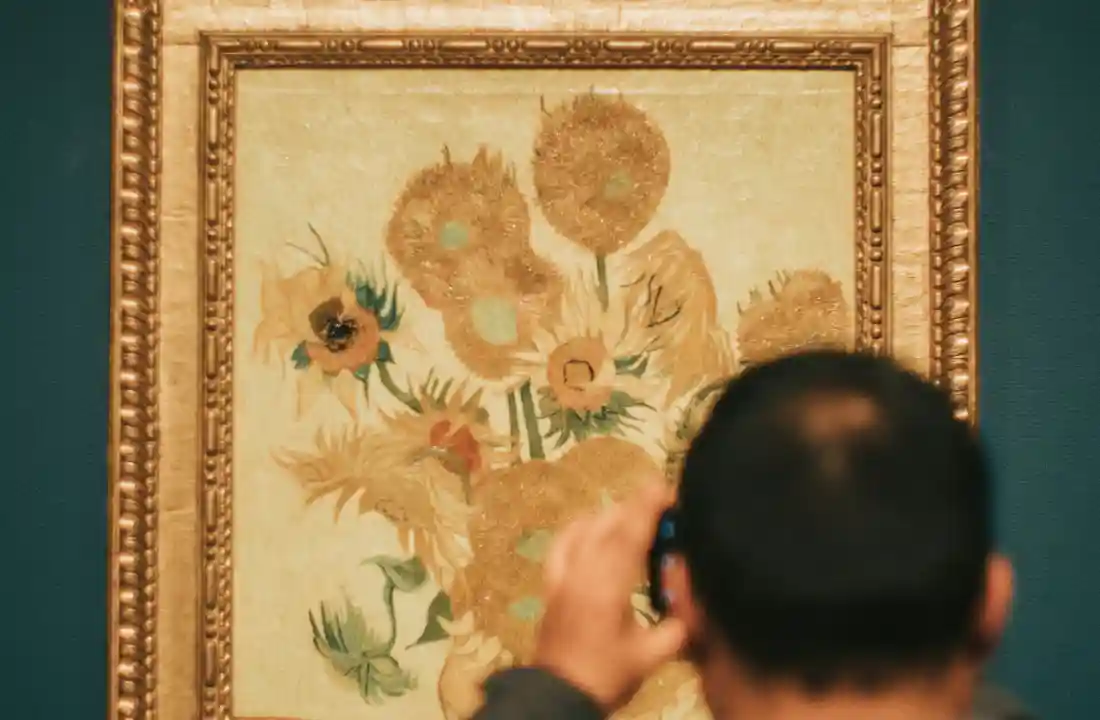
Vincent van Gogh’s Sunflowers are among the most iconic paintings in the history of art, known for their vibrant colors, expressive brushwork, and deep emotional resonance. But beyond their visual appeal, the story behind these paintings is rich with personal significance, artistic ambition, and a deep connection to the artist’s life and struggles.
The Sunflowers series was created during a particularly prolific and emotionally charged period in van Gogh’s life. In 1888, van Gogh had moved to Arles, in the south of France, seeking the light, color, and warmth that he believed would inspire his work. During his time in Arles, van Gogh painted prolifically, capturing the vibrant landscapes, the daily lives of the local people, and the intense colors of the region.
The Sunflowers series was initially conceived as a decorative element for the “Yellow House,” the home that van Gogh rented in Arles. He had a vision of creating an artist’s colony where he and other painters could live and work together, sharing ideas and inspiration. Van Gogh’s ideal collaborator was Paul Gauguin, an artist whose work he admired deeply. In anticipation of Gauguin’s arrival in Arles, van Gogh began creating a series of sunflower paintings to decorate Gauguin’s room, intending them as a symbol of friendship and a welcoming gesture.
The sunflowers in van Gogh’s paintings carry a multitude of symbolic meanings. For van Gogh, they represented gratitude, friendship, and the cycle of life. The different stages of the sunflowers—some in full bloom, others wilting—reflect the passage of time and the transient nature of life. This symbolism was particularly poignant for van Gogh, who was acutely aware of the fragility of life, both in his own struggles with mental illness and in his contemplation of the world around him.
Moreover, the sunflowers are thought to represent van Gogh’s own artistic journey. Just as sunflowers turn toward the sun, van Gogh saw his art as a way of seeking out the light, both literally in terms of the bright colors he used and metaphorically as a means of finding hope and meaning in life. The vibrant yellows and oranges he used were not just a reflection of the natural world but also a deliberate choice to convey warmth, energy, and vitality.
Van Gogh’s Sunflowers series also marks a significant point in his development as an artist. The paintings are characterized by their bold use of color, thick impasto technique, and dynamic composition. Van Gogh applied the paint in thick layers, creating a textured surface that adds depth and movement to the flowers. This technique was influenced by his admiration for Japanese prints, which he collected and studied extensively. The simplicity, clarity, and flat planes of color in these prints can be seen in the way van Gogh approached the Sunflowers series.
Additionally, the influence of the Impressionists and Post-Impressionists is evident in van Gogh’s use of color and light. However, while the Impressionists often focused on capturing fleeting moments and the effects of light, van Gogh was more concerned with expressing his emotions and inner experiences through color. In Sunflowers, the intense yellows and contrasting blues are used not just to depict the flowers but to evoke a sense of vibrancy and life.
While van Gogh’s Sunflowers were initially created as a decorative series, they have since become some of the most famous and beloved works of art in the world. The paintings are celebrated not just for their beauty but for the way they encapsulate van Gogh’s unique vision and his deep emotional connection to his subjects.
Tragically, van Gogh’s dream of an artist’s colony in Arles was never realized. His relationship with Gauguin quickly deteriorated, culminating in the infamous incident where van Gogh cut off part of his own ear. However, the Sunflowers remain as a testament to van Gogh’s ambition, his artistic innovation, and his ability to find beauty and meaning in the simplest of subjects.
Today, the Sunflowers paintings are housed in several major museums around the world, including the Van Gogh Museum in Amsterdam and the National Gallery in London. Each version of the Sunflowers is unique, reflecting the different stages of van Gogh’s creative process and his evolving approach to color and composition. Together, they offer a window into the mind of one of history’s most extraordinary artists and a reminder of the enduring power of art to convey the depths of human experience.
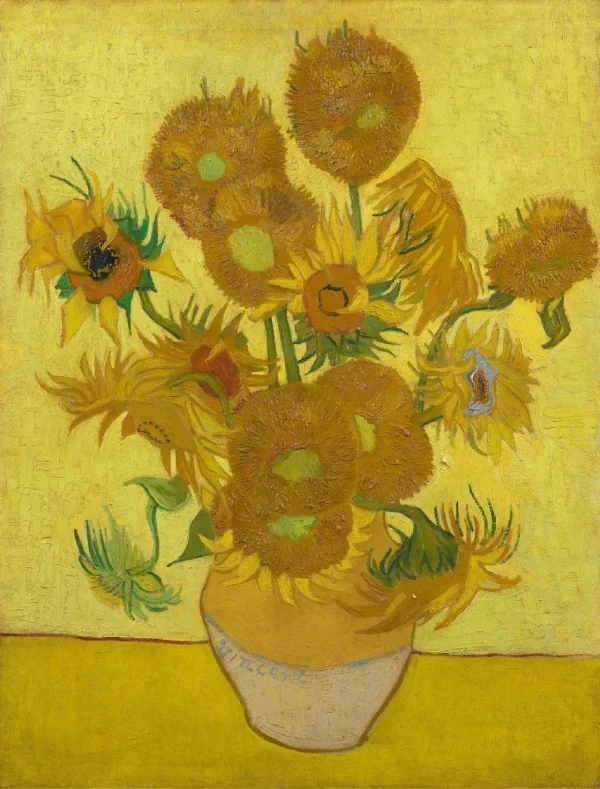
Van Gogh’s Sunflowers are celebrated for their vibrant color palette, emotional depth, and distinctive brushwork. What sets them apart is their bold use of yellow and the textured application of paint, which create a dynamic and lively depiction of the flowers. The series reflects Van Gogh’s innovative approach to color and form, as well as his ability to imbue a simple subject with profound emotional resonance. Additionally, the paintings are a symbol of friendship and hope, as they were created to welcome fellow artist Paul Gauguin to Van Gogh’s home in Arles.
Van Gogh worked on the Sunflowers series over several weeks in August and September of 1888. The exact time for each painting varied, but Van Gogh created multiple versions of Sunflowers during this period. The series includes several canvases with different compositions and stages of the flowers, all painted with Van Gogh’s characteristic impasto technique. His intense focus and enthusiasm for capturing the essence of the sunflowers reflect his deep commitment to this project.
In art, sunflowers often symbolize themes such as adoration, loyalty, and longevity. Their bright, vibrant appearance is associated with warmth, positivity, and the sun itself. For Van Gogh, sunflowers also represented gratitude and the cycle of life, with their different stages—from full bloom to wilting—mirroring the passage of time and the transient nature of existence. The sunflower’s association with the sun and light aligns with Van Gogh’s desire to capture and convey a sense of vitality and hope through his work.
The Sunflowers were painted by Vincent van Gogh, one of the most renowned artists of the Post-Impressionist movement. Van Gogh created this series of paintings in 1888 while living in Arles, France. The series is one of his most famous works and is celebrated for its vibrant color, emotive power, and innovative use of texture. Van Gogh’s approach to the sunflower series reflects his unique artistic vision and his deep emotional connection to his subjects.
Vincent van Gogh created multiple versions of the Sunflowers series. There are a total of seven known paintings in this series, each depicting sunflowers in varying stages of bloom and arranged differently. These versions are spread across different collections worldwide, including the Van Gogh Museum in Amsterdam and the National Gallery in London. The series was an exploration of the sunflower motif and Van Gogh’s experimentation with color and texture.
Van Gogh chose sunflowers as his subject for several reasons. He admired their bright, vivid color and the way they symbolized positivity and vitality. Additionally, he wanted to create a series of paintings that would serve as a warm welcome for his friend and fellow artist Paul Gauguin, who was expected to join him in Arles. The sunflowers also represented Van Gogh’s fascination with nature and his desire to explore the emotional impact of everyday objects.
The Sunflowers series significantly impacted Van Gogh’s career by highlighting his unique style and innovative use of color and texture. Although the series did not receive widespread acclaim during his lifetime, it has since become one of Van Gogh’s most celebrated works. The paintings played a key role in establishing his reputation as a leading figure in Post-Impressionism and continue to influence and inspire artists and art enthusiasts around the world.
More information about the Van Gogh Museum
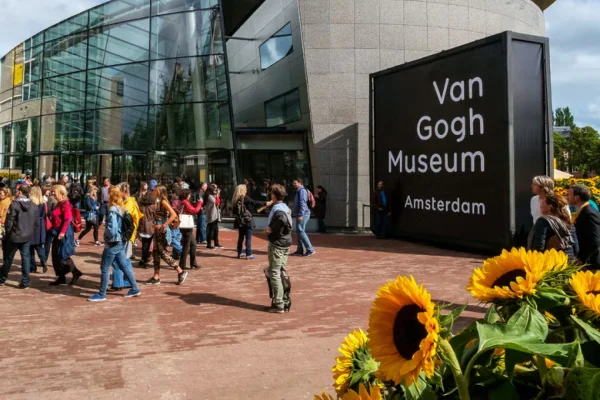
VAN GOGH MUSEUM TICKETS
You can only buy tickets for the Van Gogh Museum online. Van Gogh museum ticket price is 32€. The ticket includes entry…
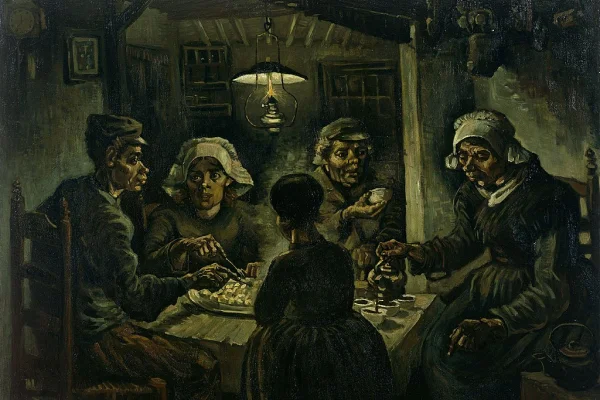
VAN GOGH INFORMATION
Vincent van Gogh was a renowned Dutch artist known for his striking and vibrant works, which remain highly influential in art…
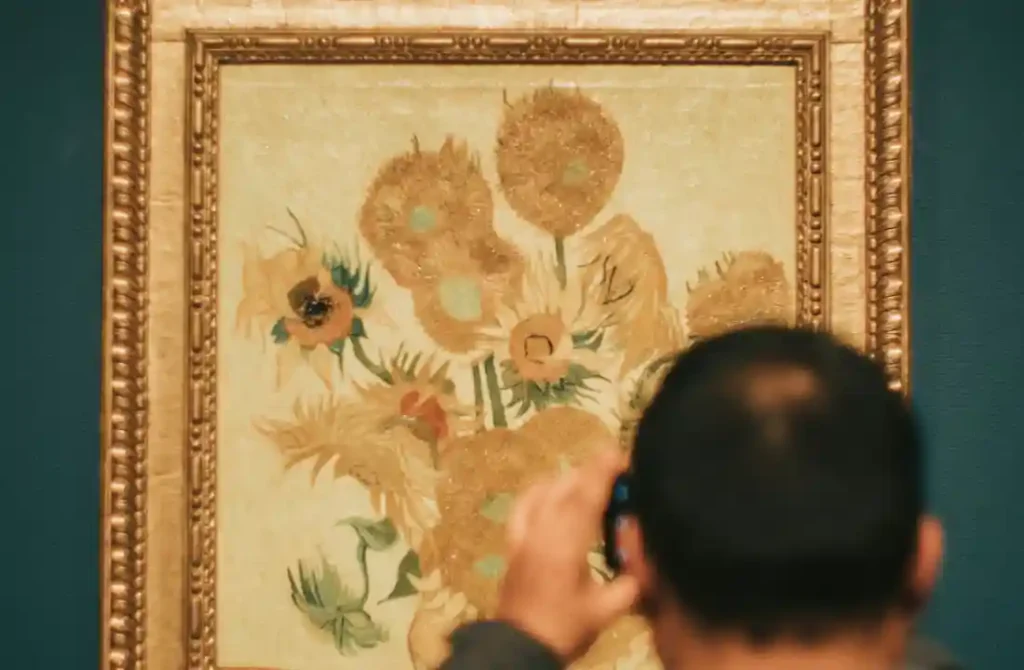
VAN GOGH INFORMATION
The Sunflowers series primarily depicts a vase filled with sunflowers at different stages of life, from full bloom to wilting…
Top things to do in Amsterdam
